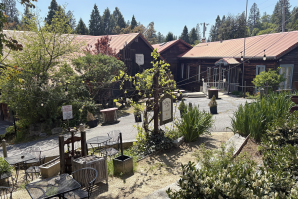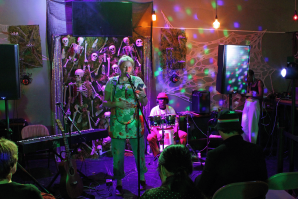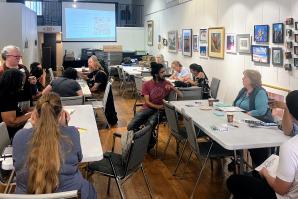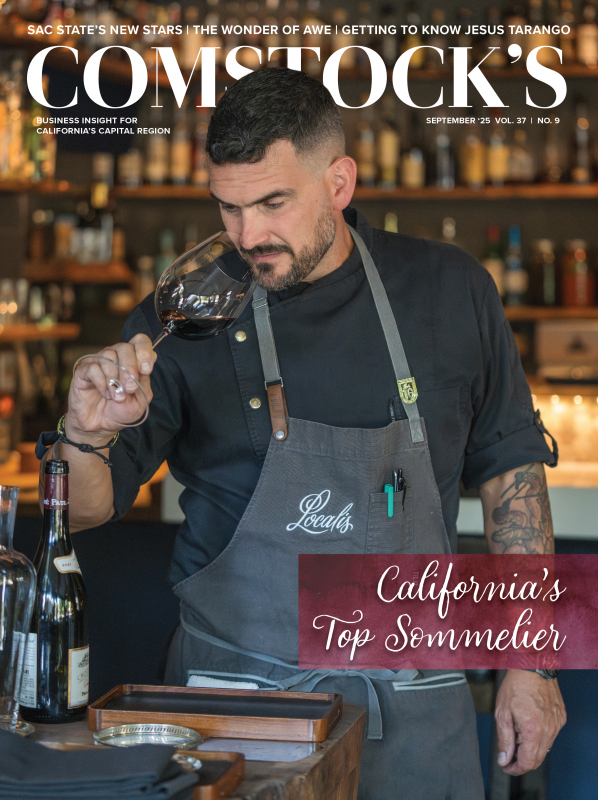A hair salon owner, a business consultant, a massage therapist and a loan-refinancing service provider. These were some of the entrepreneurs pitching to attract potential investors one evening this past June in Sacramento. Many hoped to raise $25,000 for their businesses, while others shot for $250,000. This wasn’t an episode of “Shark Tank.” It was the end of a 12-week business training program funded by the city, not through the Office of Innovation and Economic Development, which bankrolls several incubators and accelerators; rather, the Office of Arts and Culture footed the bill.
The EveryDay Creative program, operated by the community development cooperation CLTRE, is one of a handful of initiatives the OAC has funded in recent years aimed at growing the creative economy, which is typically thought of as all businesses making or selling cultural goods or services. More than 100 people applied, and 20 were selected. Among the chosen entrepreneurs were a bookstore owner, a podcast producer, a dance instructor and a fashion designer. Also in the group were two marketing agencies and a retailer who sells mushroom-growing kits. Each received a grant up to $5,000. It’s a deviation from who OAC has historically funded.
“Is it traditional? No,” says Megan Van Voorhis, head of the city’s Department of Convention and Cultural Services, which oversees the OAC. “Traditionally, we funded arts and culture. Traditionally, we funded nonprofit arts and cultural organizations, and predominantly, if you look at the city’s history of funding, major institutions. That’s sort of the legacy in terms of the way we funded it.”
Van Voorhis said EveryDay Creative is just one initiative and shouldn’t be viewed in isolation. Her goal is for the city to grow “a complete portfolio of the creative industries.” This program aids in that by supporting all kinds of businesses. When pressed about the participants, on what is or isn’t a creative business, her list of caveats grew longer and longer. One way Van Voorhis put it during an interview was to say, “The community defines it.” In other words, who’s to say?
“It’s really hard to get the full gamut of it,” Van Voorhis says, “because that’s why it’s creative.”
The money
The OAC originated in 1977 as the Sacramento Metropolitan Arts Commission, an advisory committee jointly operated by the city and Sacramento County. Its job was to manage both municipalities’ arts programs, according to the Sacramento Bee via Newspapers.com. From inception, SMAC coordinated a team of 20 visual artists, organized exhibitions and awarded grants for mural paintings and educational programs. Its budget was heavily slashed during the Great Recession and by 2017 hadn’t been restored. It was at that time that the head of SMAC’s role was expanded to support the creative economy.
This was when the city adopted Creative Edge, a seven-year plan with goals and strategies for developing the arts scene. SMAC became OAC after the county ended the joint agreement and the city raised the department’s budget to around two million. That’s minuscule compared to the total city budget of $1.67 billion, but a lot of OAC’s spending money comes from state and federal agencies.
It wasn’t until after the American Rescue Plan Act (ARPA) was enacted in 2021 that the department got the money to take these recent big experimental swings. Previously, OAC used $20 million allocated from the CARES Act for grants to over 500 local artists, nonprofits and businesses. With the $10 million the city allocated for it from the ARPA federal stimulus package, the OAC could spend the money on programs and services to combat the economic impacts of the pandemic.
“The ARPA money has become, just overall, the foundation for us to be able to advance Creative Edge in ways that I’m not sure we would have been able to do without it,” Van Voorhis says.
So what did they buy? The OAC spent much of its ARPA money on grants to prop up local institutions: $2 million for nonprofits, at least $1.5 million for events like music and food festivals, and $410,000 for businesses. It also funded novel initiatives. Solving Sacramento was given $250,000 to cover arts and culture. (Disclosure: last year, I wrote a profile funded by this grant on a body paint artist.)
“I want best-in-class education for creative entrepreneurs accessible in this town. And that’s what we get.”
Megan Van Voorhis, director, Sacramento Department of Convention and Cultural Services
OAC announced over a million dollars from its ARPA fund had been allocated for workforce readiness programs for teens and young adults, although Van Voorhis said the funding source for the program was changed. ARPA funds also went to support educational programming on online permitting at the newly created Entertainment Services Division.
The arts department also put out a request for proposals, Van Voorhis said. After Creative Edge was adopted in 2017, the city awarded $500,000 in grants to pitched projects aimed at growing the creative economy, which largely paid for festivals, workshops and public art installations. This time the OAC was looking for professional education programs for entrepreneurs.
In 2023, the pilot for EveryDay Creative was launched in this vein. OAC spent $750,000 in ARPA money to fund the expanded program for two years. It includes a six-week incubator for entrepreneurs just starting out, each getting a $1,500 grant, and a 12-week accelerator for more established businesses, who receive $3,000 to $5,000 upon completion. There’s talk of providing participants additional financing, but the details haven’t been finalized. Creative Startups developed the curriculum and CLTRE recruited and coordinated the applicants. The program is a means to help small businesses grow, network and get funding, which was a goal for Van Voorhis.
“I want best-in-class education for creative entrepreneurs accessible in this town,” Van Voorhis says. “And that’s what we get.”
‘A new era’
Some community leaders believe supporting the arts is more than just helping people make money. Liv Moe is the founding director of the Verge Center for the Arts, a studio and exhibition space in Sacramento, and is board president of the Sacramento Alliance for Regional Arts. She said OAC also needs to invest, not just in new programs, but also in growing established institutions because they offer the city’s creatives employment and the space to showcase their work, meet and connect. The capital lacks exhibition opportunities. “I hate to say it, but Oakland is running circles around us,” Moe says.
The danger of OAC having too much of a focus on economic development, according to Moe, is “it strips the soul out of everything.” A city loses its cool if all art is solely made for retail. It needs engaging events that draw in creatives to convince them to stay. She worries the city will devalue art that isn’t commodifiable.
“There are some experiences that are just great experiences, and you’re not going to sell them, but they’re part of what makes a community interesting,” Moe says. “That’s the vision we’ve lost in the last six years, and I don’t know if we’re going to get it back.”
Megan Wygant also has thoughts on how the city should allocate its funding for the arts at a time of increasing need. She is the executive director of the E. Claire Raley Studios for the Performing Arts, which houses several dance and theater groups in Sacramento. Wygant said many arts and culture organizations have not fully recovered from the pandemic, and there’s less money coming from the state after the California Arts Council had its budget cut by $5 million. “You’re seeing a lot of companies start to wobble,” Wygant says.
“There are some experiences that are just great experiences, and you’re not going to sell them, but they’re part of what makes a community interesting.”
Liv Moe, founding director, of the Verge Center for the Arts
While EveryDay Creative targets the underserved BIPOC (Black, Indigenous, and People of Color) community, Wygant worries about “duplicating efforts.” The city already had similar initiatives by local organizations such as the Calling All Dreamers program and SVP Fast Pitch. At the time of writing, the city faces a $62.2 million budget deficit. In a world of finite resources, and if push comes to shove, she said OAC should prioritize funding for “institutional stalwarts” over new programming.
“They’re having to make tough choices, and it would be great if everything were fundable,” Wygant says. “I understand the strategic direction that they’re taking. I wish that conversation had been more transparent.”
Megan Wygant, executive director of E. Claire Raley Studios for
the Performing Arts, says many arts and culture organizations
have not fully recovered from the pandemic.

“I’m looking at it from the lens of my creatives. They now feel love from the city of Sacramento. They feel seen, which was very different years ago when they just felt insignificant.”
Shira Lane, founder, Atrium 916
From an administrator’s perspective, Lane said, it’s always been easier to award a grant to a nonprofit over an individual because they have the resources to manage the bureaucracy. Giving large sums of cash to a single artist is risky because they could lack the time or financial literacy to handle paperwork properly. Working with them comes with an increased administrative burden, and she commends the OAC for taking it on.
“I’m looking at it from the lens of my creatives,” Lane says. “They now feel love from the city of Sacramento. They feel seen, which was very different years ago when they just felt insignificant.”
As for the most recent EveryDay Creative cohort, Lane sees how entrepreneurs like the two marketing firms in the program could be considered creative businesses. That said, she wishes the group had more folks explicitly involved in arts and culture. “There was a little bit that was out of the scope. I really was hoping to see a little bit more in the scope,” Lane says.
The future
While EveryDay Creative focuses on small businesses, OAC funded another education program with ARPA money, this time centered around musicians. In May, OAC awarded $150,000 to the Department of Sound for its Sound Business Summit program, which features a series of workshops in partnership with the Center for Creative Entrepreneurship to teach professional musicians the ins and outs of licensing, royalties, booking, merchandise and other revenue streams. The nonprofit’s CEO, J. Hamilton Hodgson, told me they raised additional funds to double the cohort size to more than 100 due to demand.
A few decades ago, Hodgson said musicians had to travel to cultural centers like New York City, Los Angeles or London for opportunities. “Now that so much of this is online, Sacramento can have more of a creative industry here,” he says. The Making Money with Music workshops launches in October and aims to make it easier for musicians to afford living in Sacramento and pursue their stardom here.
“We see people who don’t do this anymore because they’re essentially priced out. So if people can gain some revenue from their music, that’s our goal,” Hodgson says. “Time and time again, the community brings artists up, and then they leave right when they’re about to pop. They leave Sacramento because there are no opportunities here.”
Making Money with Music, like all of OAC’s ARPA funded projects, was launched without long-term funding in place. Two million dollars from the remaining funds will go toward paying up to 200 artists $850 a month for a year as part of the Creative Growth Fellowship Program, which was originally pitched as a universal basic income program before adjustments. What’s leftover will be used to support the existing programs. The next task for Van Voorhis after all the ARPA money has been spent is to help secure long term funding so these new programs can continue.
“We’re trying to identify other resources to be able to do that,” Van Voorhis says. “This was always going to be a challenge for us, was making sure that the resources are available post (ARPA funding), but we can’t let that get in the way of making good investments and building strong partnerships.”
Correction Sept. 8, 2025: A previous version of this article stated that Solving Sacramento received $250,000 to pay freelancers to write about 120 articles relating to arts and culture. It has been amended to reflect that the grant does not only cover paying freelancers.
–
Stay up to date on business in the Capital Region: Subscribe to the Comstock’s newsletter today.
Recommended For You

Why Are Big-Name Bands Playing at These Mountain Town Venues?
Venues in Nevada City and Grass Valley attract name acts, and the scene could be growing
Quietly, a robust live music scene has emerged in the foothills, with several venues able to draw in well-known acts. And if the changes in Grass Valley are emblematic of another thing, it’s that this sector is growing.

Crocker Art Museum Finds a New Leader
Agustin Arteaga to begin July 1 as Mort and Marcy Friedman director and CEO, taking over for longtime leader Lial Jones
Born in Mexico City, Arteaga arrives in Sacramento after a long and varied career. Most recently director of the Dallas Museum of Art, he also served as director of Mexico’s Museo Nacional de Arte and the Museo de Arte de Ponce in Puerto Rico and was founding director of Argentina’s Museo de Arte Latinoamericano de Buenos Aires.

The Value of Art
4 years out of the pandemic, Sacramento’s arts scene brings in tourism and tax dollars
A 2022 study conducted by Americans for the Arts in partnership with Sacramento Alliance for Regional Arts found that nonprofit arts- and culture-related activities in Sacramento County injected over $241 million into the local economy.

The Capital City Celebrates Inaugural Sacramento Poetry Week
The week was a host to a variety of events featuring new and veteran poets
Spoken word took over the capital last week as the city celebrated its inaugural Sacramento Poetry Week.

New Arts Council on Horizon for San Joaquin County
Organizers aim to unite the creative sector, provide equitable access countywide
San Joaquin County — with its rich cultural and historical heritage in both rural communities and city centers — may soon have a unified creative and cultural front. For the first time since 2001, the county will again have an arts council.




